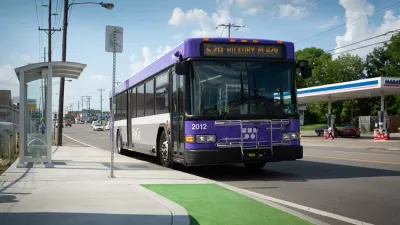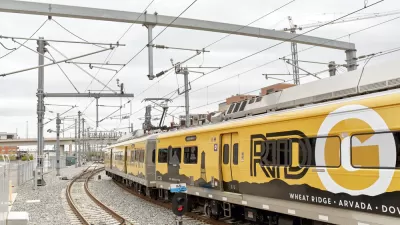Under the cover of darkness two years ago, Tallahassee's StarMetro completely overhauled its entire bus system, replacing its out of date hub-and-spoke model with a grid-like system over one evening. This year, the system was honored by the APA.
Ryan Holeywell explains the radical transformation that earned Tallahassee's StarMetro transit agency the 2013 National Planning Excellence Award for Transportation Planning.
When Tallahassee eliminated every existing bus route and replaced them with new ones in one evening nearly two years ago, "the goal was to replace the city's existing hub-and-spoke bus route system -- in which every single one of the city's bus routes led to a downtown transfer station -- with a grid-like system that more accurately reflected the population and employment clusters in Florida's capital city."
Although the city undertook five years of planning and a vigorous public outreach campaign, the transition was still jarring. According to Holeywell, "Ridership shot up 10 percent, leading to overcrowding and delays. The transit agency had a system that allowed passengers to request information on wait times via text message, but it crashed under the unprecedented number of inquiries. Officials say problems and confusion lasted for about a month before things returned to normal."
Despite the initial hiccups, as the APA's award announcement notes, the long term improvements to operations and ridership have been substantial: "The new transit system reduced transfers at the downtown terminal by 30 percent; decreased total transfers system-wide by 14 percent; decreased the number of routes that share at least one mile of service from 21 to two and increased ridership by 21 percent in December 2011."
FULL STORY: How Tallahassee Overhauled Its Transit System Overnight

Alabama: Trump Terminates Settlements for Black Communities Harmed By Raw Sewage
Trump deemed the landmark civil rights agreement “illegal DEI and environmental justice policy.”

Study: Maui’s Plan to Convert Vacation Rentals to Long-Term Housing Could Cause Nearly $1 Billion Economic Loss
The plan would reduce visitor accommodation by 25% resulting in 1,900 jobs lost.

Why Should We Subsidize Public Transportation?
Many public transit agencies face financial stress due to rising costs, declining fare revenue, and declining subsidies. Transit advocates must provide a strong business case for increasing public transit funding.

Paris Bike Boom Leads to Steep Drop in Air Pollution
The French city’s air quality has improved dramatically in the past 20 years, coinciding with a growth in cycling.

Why Housing Costs More to Build in California Than in Texas
Hard costs like labor and materials combined with ‘soft’ costs such as permitting make building in the San Francisco Bay Area almost three times as costly as in Texas cities.

San Diego County Sees a Rise in Urban Coyotes
San Diego County experiences a rise in urban coyotes, as sightings become prevalent throughout its urban neighbourhoods and surrounding areas.
Urban Design for Planners 1: Software Tools
This six-course series explores essential urban design concepts using open source software and equips planners with the tools they need to participate fully in the urban design process.
Planning for Universal Design
Learn the tools for implementing Universal Design in planning regulations.
Smith Gee Studio
Alamo Area Metropolitan Planning Organization
City of Santa Clarita
Institute for Housing and Urban Development Studies (IHS)
City of Grandview
Harvard GSD Executive Education
Toledo-Lucas County Plan Commissions
Salt Lake City
NYU Wagner Graduate School of Public Service





























